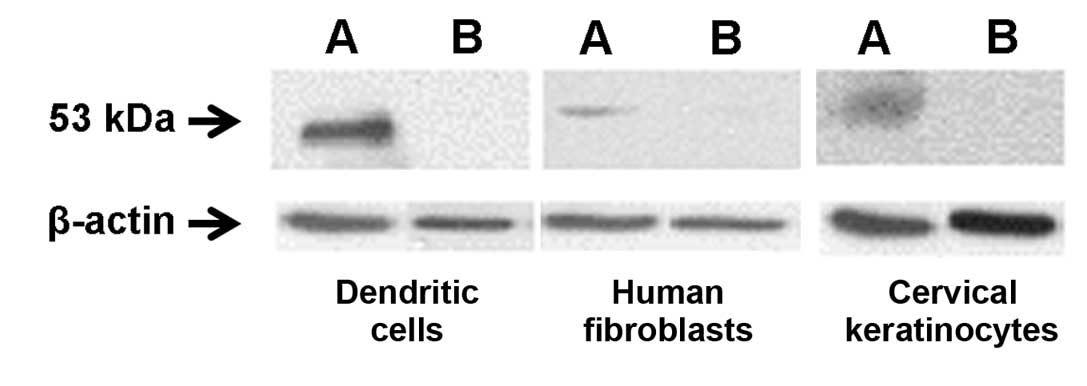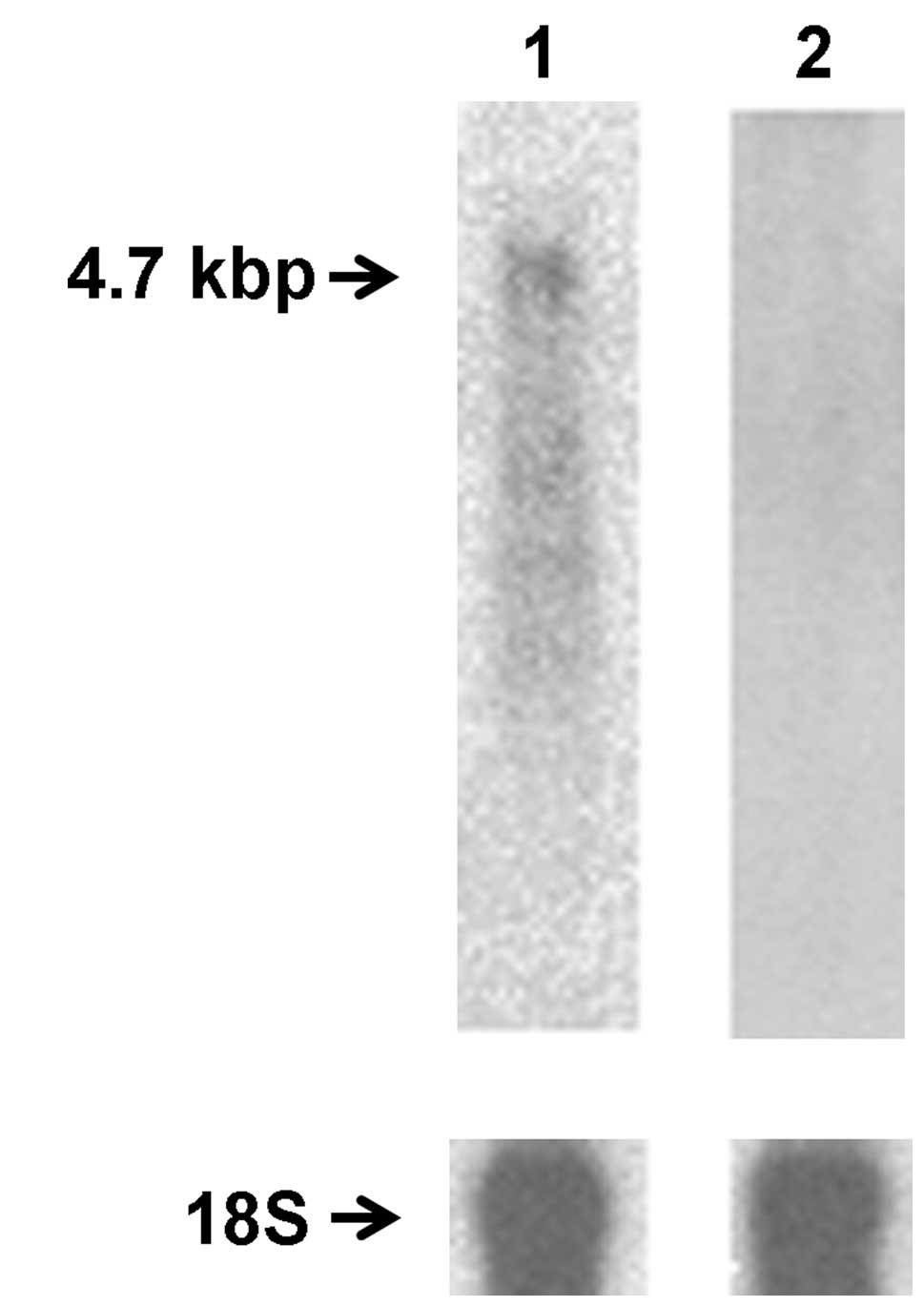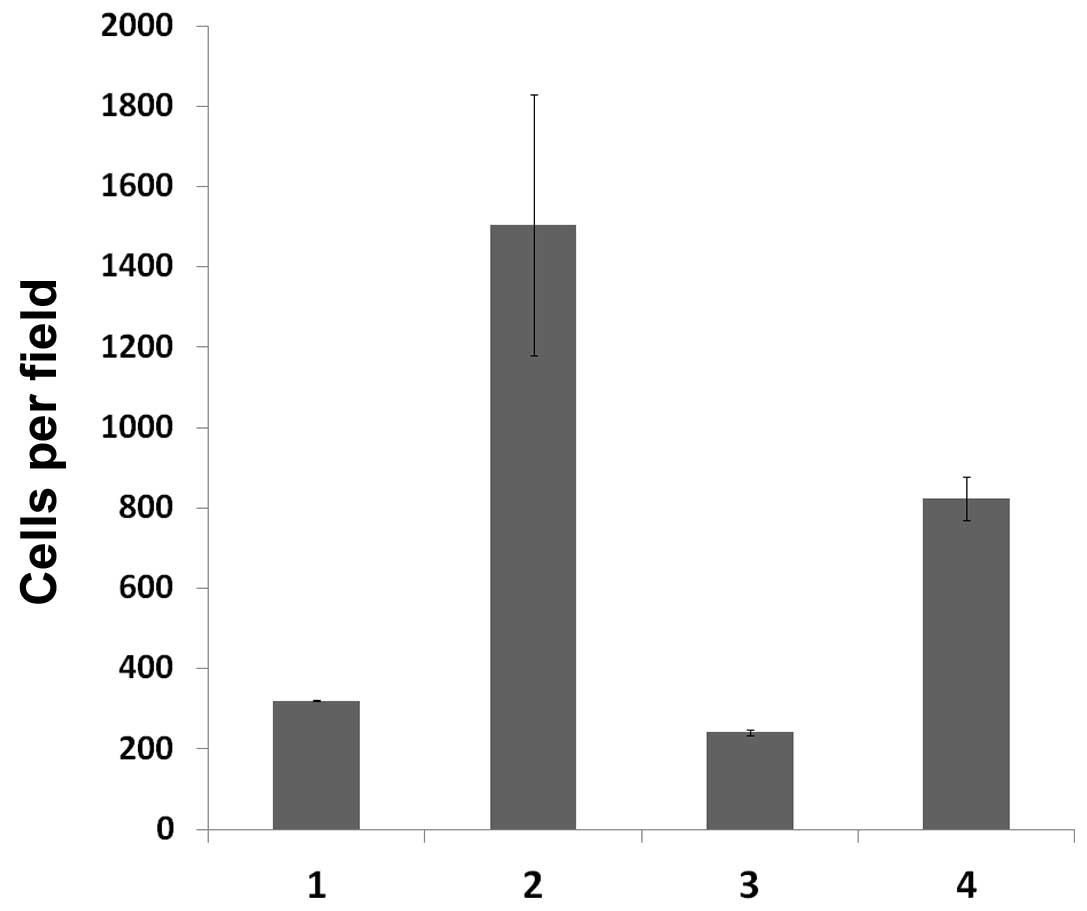|
1.
|
zur Hausen H: Papillomavirus infections -
a major cause of human cancers. Biochim Biophys Acta. 1288:F55–F78.
1996.PubMed/NCBI
|
|
2.
|
Kanodia S, Fahey LM and Kast WM:
Mechanisms used by human papillomaviruses to escape the host immune
response. Curr Cancer Drug Targets. 7:79–89. 2007. View Article : Google Scholar : PubMed/NCBI
|
|
3.
|
Frazer IH: The role of the immune system
in anogenital human papillomavirus. Australas J Dermatol. 39(Suppl
1): S5–S7. 1998.PubMed/NCBI
|
|
4.
|
al-Saleh W, Giannini SL, Jacobs N, et al:
Correlation of T-helper secretory differentiation and types of
antigen-presenting cells in squamous intraepithelial lesions of the
uterine cervix. J Pathol. 184:283–290. 1998. View Article : Google Scholar
|
|
5.
|
Coleman N, Birley HD, Renton AM, et al:
Immunological events in regressing genital warts. Am J Clin Pathol.
102:768–774. 1994.PubMed/NCBI
|
|
6.
|
al-Saleh W, Delvenne P, Arrese JE, Nikkels
AF, Pierard GE and Boniver J: Inverse modulation of intraepithelial
Langerhans’ cells and stromal macrophage/dendrocyte populations in
human papillomavirus-associated squamous intraepithelial lesions of
the cervix. Virchows Arch. 427:41–48. 1995.
|
|
7.
|
McArdle JP and Muller HK: Quantitative
assessment of Langerhans’ cells in human cervical intraepithelial
neoplasia and wart virus infection. Am J Obstet Gynecol.
154:509–515. 1986.
|
|
8.
|
Morelli AE, Sananes C, Di Paola G, Paredes
A and Fainboim L: Relationship between types of human
papillomavirus and Langerhans’ cells in cervical condyloma and
intraepithelial neoplasia. Am J Clin Pathol. 99:200–206. 1993.
|
|
9.
|
Morris HH, Gatter KC, Stein H and Mason
DY: Langerhans’ cells in human cervical epithelium: an
immunohistological study. Br J Obstet Gynaecol. 90:400–411.
1983.
|
|
10.
|
Viac J, Guerin-Reverchon I, Chardonnet Y
and Bremond A: Langerhans cells and epithelial cell modifications
in cervical intraepithelial neoplasia: correlation with human
papillomavirus infection. Immunobiology. 180:328–338. 1990.
View Article : Google Scholar
|
|
11.
|
Abbas AK, Lichtman AH and Pober JS:
Cellular and Molecular Immunology. Saunders; Philadelphia, PA:
1997
|
|
12.
|
Breathnach SM: The Langerhans cell. Br J
Dermatol. 119:463–469. 1988. View Article : Google Scholar
|
|
13.
|
Melief CJ: Dendritic cells as specialized
antigen-presenting cells. Res Immunol. 140:902–906; discussion
918–926, 1989.
|
|
14.
|
Mota F, Rayment N, Chong S, Singer A and
Chain B: The antigen-presenting environment in normal and human
papillomavirus (HPV)-related premalignant cervical epithelium. Clin
Exp Immunol. 116:33–40. 1999. View Article : Google Scholar : PubMed/NCBI
|
|
15.
|
Hubert P, van den Brule F, Giannini SL,
Franzen-Detrooz E, Boniver J and Delvenne P: Colonization of in
vitro-formed cervical human papillomavirus-associated
(pre)neoplastic lesions with dendritic cells: role of
granulocyte/macrophage colony-stimulating factor. Am J Pathol.
154:775–784. 1999. View Article : Google Scholar
|
|
16.
|
Arany I, Goel A and Tyring SK: Interferon
response depends on viral transcription in human
papillomavirus-containing lesions. Anticancer Res. 15:2865–2869.
1995.PubMed/NCBI
|
|
17.
|
Park JS, Kim EJ, Kwon HJ, Hwang ES,
Namkoong SE and Um SJ: Inactivation of interferon regulatory
factor-1 tumor suppressor protein by HPV E7 oncoprotein.
Implication for the E7-mediated immune evasion mechanism in
cervical carcinogenesis. J Biol Chem. 275:6764–6769. 2000.
View Article : Google Scholar
|
|
18.
|
Evander M, Frazer IH, Payne E, Qi YM,
Hengst K and McMillan NA: Identification of the alpha6 integrin as
a candidate receptor for papillomaviruses. J Virol. 71:2449–2456.
1997.PubMed/NCBI
|
|
19.
|
Price AA, Cumberbatch M, Kimber I and Ager
A: Alpha 6 integrins are required for Langerhans cell migration
from the epidermis. J Exp Med. 186:1725–1735. 1997. View Article : Google Scholar : PubMed/NCBI
|
|
20.
|
Bonnez W, Reichman RC, Strussenberg J and
Roberts NJ Jr: In vitro interactions between bovine papillomavirus
and human monocytes and macrophages. Intervirology. 32:246–252.
1991.PubMed/NCBI
|
|
21.
|
Tagami H, Oguchi M and Ofuji S: The
phenomenon of spontaneous regression of numerous flat warts:
immunohistological studies. Cancer. 45:2557–2563. 1980. View Article : Google Scholar : PubMed/NCBI
|
|
22.
|
Beutner KR and Tyring S: Human
papillomavirus and human disease. Am J Med. 102:9–15. 1997.
View Article : Google Scholar : PubMed/NCBI
|
|
23.
|
Shah KV and Howley PM: Papillomaviruses.
Fields BN, Knipe DM and Howley M: Fields Virology. 3rd edition.
Lippincott-Raven Publishers; Philadelphia, PA: pp. 2077–2109.
1996
|
|
24.
|
Le Buanec H, D’Anna R, Lachgar A, et al:
HPV-16 E7 but not E6 oncogenic protein triggers both cellular
immunosuppression and angiogenic processes. Biomed Pharmacother.
53:424–431. 1999.
|
|
25.
|
Carter JJ, Koutsky LA, Hughes JP, et al:
Comparison of human papillomavirus types 16, 18, and 6 capsid
antibody responses following incident infection. J Infect Dis.
181:1911–1919. 2000. View
Article : Google Scholar : PubMed/NCBI
|
|
26.
|
Lin YL, Borenstein LA, Selvakumar R, Ahmed
R and Wettstein FO: Progression from papilloma to carcinoma is
accompanied by changes in antibody response to papillomavirus
proteins. J Virol. 67:382–389. 1993.PubMed/NCBI
|
|
27.
|
Park JS, Park DC, Kim CJ, et al:
HPV-16-related proteins as the serologic markers in cervical
neoplasia. Gynecol Oncol. 69:47–55. 1998. View Article : Google Scholar : PubMed/NCBI
|
|
28.
|
Steele JC and Gallimore PH: Humoral assays
of human sera to disrupted and nondisrupted epitopes of human
papillomavirus type 1. Virology. 174:388–398. 1990. View Article : Google Scholar : PubMed/NCBI
|
|
29.
|
Suzich JA, Ghim SJ, Palmer-Hill FJ, et al:
Systemic immunization with papillomavirus L1 protein completely
prevents the development of viral mucosal papillomas. Proc Natl
Acad Sci USA. 92:11553–11557. 1995. View Article : Google Scholar : PubMed/NCBI
|
|
30.
|
Frazer IH, Thomas R, Zhou J, et al:
Potential strategies utilised by papillomavirus to evade host
immunity. Immunol Rev. 168:131–142. 1999. View Article : Google Scholar : PubMed/NCBI
|
|
31.
|
Rosl F, Lengert M, Albrecht J, et al:
Differential regulation of the JE gene encoding the monocyte
chemoattractant protein (MCP-1) in cervical carcinoma cells and
derived hybrids. J Virol. 68:2142–2150. 1994.PubMed/NCBI
|
|
32.
|
Santin AD, Hermonat PL, Ravaggi A, et al:
Development, characterization and distribution of adoptively
transferred peripheral blood lymphocytes primed by human
papillomavirus 18 E7 - pulsed autologous dendritic cells in a
patient with metastatic adenocarcinoma of the uterine cervix. Eur J
Gynaecol Oncol. 21:17–23. 2000.
|
|
33.
|
Carlson MW, Iyer VR and Marcotte EM:
Quantitative gene expression assessment identifies appropriate cell
line models for individual cervical cancer pathways. BMC Genomics.
8:1172007. View Article : Google Scholar : PubMed/NCBI
|
|
34.
|
Miyasaka M, Takami Y, Inoue H and Hakura
A: Rat primary embryo fibroblast cells suppress transformation by
the E6 and E7 genes of human papillomavirus type 16 in somatic
hybrid cells. J Virol. 65:479–482. 1991.
|
|
35.
|
Yutsudo M, Okamoto Y and Hakura A:
Functional dissociation of transforming genes of human
papillomavirus type 16. Virology. 166:594–597. 1988. View Article : Google Scholar : PubMed/NCBI
|
|
36.
|
Cumberbatch M, Dearman RJ and Kimber I:
Constitutive and inducible expression of interleukin-6 by
Langerhans cells and lymph node dendritic cells. Immunology.
87:513–518. 1996. View Article : Google Scholar : PubMed/NCBI
|
|
37.
|
Saitoh A, Yasaka N, Osada A, Nakamura K,
Furue M and Tamaki K: Migration of Langerhans cells in an in vitro
organ culture system: IL-6 and TNF-alpha are partially responsible
for migration into the epidermis. J Dermatol Sci. 19:166–174. 1999.
View Article : Google Scholar : PubMed/NCBI
|
|
38.
|
Stoitzner P, Zanella M, Ortner U, et al:
Migration of langerhans cells and dermal dendritic cells in skin
organ cultures: augmentation by TNF-alpha and IL-1beta. J Leukoc
Biol. 66:462–470. 1999.PubMed/NCBI
|
|
39.
|
Hope JC, Cumberbatch M, Fielding I,
Dearman RJ, Kimber I and Hopkins SJ: Identification of dendritic
cells as a major source of interleukin-6 in draining lymph nodes
following skin sensitization of mice. Immunology. 86:441–447.
1995.PubMed/NCBI
|
|
40.
|
Gibran NS, Ferguson M, Heimbach DM and
Isik FF: Monocyte chemoattractant protein-1 mRNA expression in the
human burn wound. J Surg Res. 70:1–6. 1997. View Article : Google Scholar : PubMed/NCBI
|
|
41.
|
Shreedhar V, Giese T, Sung VW and Ullrich
SE: A cytokine cascade including prostaglandin E2, IL-4, and IL-10
is responsible for UV-induced systemic immune suppression. J
Immunol. 160:3783–3789. 1998.PubMed/NCBI
|
|
42.
|
Mantovani A, Bottazzi B, Colotta F,
Sozzani S and Ruco L: The origin and function of tumor-associated
macrophages. Immunol Today. 13:265–270. 1992. View Article : Google Scholar : PubMed/NCBI
|
|
43.
|
Miller MD and Krangel MS: Biology and
biochemistry of the chemokines: a family of chemotactic and
inflammatory cytokines. Crit Rev Immunol. 12:17–46. 1992.PubMed/NCBI
|
|
44.
|
Muller WA and Randolph GJ: Migration of
leukocytes across endothelium and beyond: molecules involved in the
transmigration and fate of monocytes. J Leukoc Biol. 66:698–704.
1999.PubMed/NCBI
|
|
45.
|
Kleine K, Konig G, Kreuzer J, Komitowski
D, Zur Hausen H and Rosl F: The effect of the JE (MCP-1) gene,
which encodes monocyte chemoattractant protein-1, on the growth of
HeLa cells and derived somatic-cell hybrids in nude mice. Mol
Carcinog. 14:179–189. 1995. View Article : Google Scholar : PubMed/NCBI
|
|
46.
|
Braun L, Durst M, Mikumo R, Crowley A and
Robinson M: Regulation of growth and gene expression in human
papillomavirus-transformed keratinocytes by transforming growth
factor-beta: implications for the control of papillomavirus
infection. Mol Carcinog. 6:100–111. 1992. View Article : Google Scholar
|
|
47.
|
Ozbun MA and Meyers C: Transforming growth
factor beta1 induces differentiation in human
papillomavirus-positive keratinocytes. J Virol. 70:5437–5446.
1996.PubMed/NCBI
|
|
48.
|
Borkowski TA, Letterio JJ, Farr AG and
Udey MC: A role for endogenous transforming growth factor beta 1 in
Langerhans cell biology: the skin of transforming growth factor
beta 1 null mice is devoid of epidermal Langerhans cells. J Exp
Med. 184:2417–2422. 1996. View Article : Google Scholar : PubMed/NCBI
|
|
49.
|
Geissmann F, Prost C, Monnet JP, Dy M,
Brousse N and Hermine O: Transforming growth factor beta1, in the
presence of granulocyte/macrophage colony-stimulating factor and
interleukin 4, induces differentiation of human peripheral blood
monocytes into dendritic Langerhans cells. J Exp Med. 187:961–966.
1998. View Article : Google Scholar
|
|
50.
|
Sato K, Kawasaki H, Nagayama H, et al:
TGF-beta 1 reciprocally controls chemotaxis of human peripheral
blood monocyte-derived dendritic cells via chemokine receptors. J
Immunol. 164:2285–2295. 2000. View Article : Google Scholar
|
|
51.
|
Strobl H and Knapp W: TGF-beta1 regulation
of dendritic cells. Microbes Infect. 1:1283–1290. 1999. View Article : Google Scholar : PubMed/NCBI
|
|
52.
|
Nunez R, Sanchez M, Wild P, Filgueira L
and Nunez C: Characterisation of two human dendritic cell-lines
that express CD1a, take-up, process and present soluble antigens
and induce MLR. Immunol Lett. 61:33–43. 1998. View Article : Google Scholar : PubMed/NCBI
|
|
53.
|
Cole ST and Danos O: Nucleotide sequence
and comparative analysis of the human papillomavirus type 18
genome. Phylogeny of papillomaviruses and repeated structure of the
E6 and E7 gene products. J Mol Biol. 193:599–608. 1987. View Article : Google Scholar : PubMed/NCBI
|
|
54.
|
Dunzendorfer S, Kaser A, Meierhofer C,
Tilg H and Wiedermann CJ: Dendritic cell migration in different
micropore filter assays. Immunol Lett. 71:5–11. 2000. View Article : Google Scholar : PubMed/NCBI
|
















